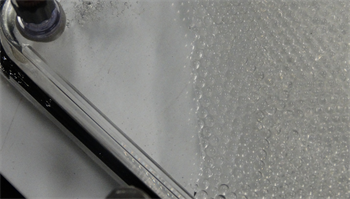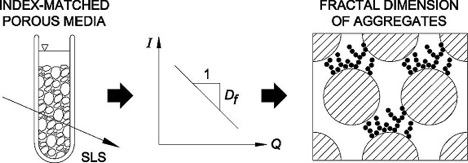Permeability Research
According to Darcy's law, fluid flow in porous media is proportional to the permeability. Accordingly, any technology involving porous media—such as groundwater remediation, aquifer storage and recovery, or geothermal energy—depends on maintenance of adequate permeability. This is why clogging, a detrimental reduction in permeability, is a fundamental problem. Among several mechanisms causing clogging, my group focuses on colloids, which are particles with diameters between 1 nm and 10 μm. This mechanism is important, because when colloids deposit in porous media, permeability can be reduced by up to three orders of magnitude. My group investigates the hypothesis that clogging depends on the structure of colloid deposits, called deposit morphology.
 |  |
| Refractive index matched (RIM) porous media. Image by Eric Roth and Ryan Tigera © 2015. | Refractive index matched (RIM) porous media. Image by Eric Roth and Ryan Tigera © 2015. |
BASIC SCIENCE
Basic science aspects of our permeability research are reported in the following refereed publications:
- Inverse method to determine hydraulic conductivity from a velocity field using graph theory (Mont-Eton et al. 2024)
- Experimental measurement of clogging as a function of colloid deposit morphology (Roth et al. 2015b).
- Measurement of colloid deposit fractal dimension and radius of gyration (Roth et al. 2015a ).
- Measurement of colloid aggregate fractal dimension in RIM porous media (Mays et al. 2011 ).
- Contrasting clogging in granular media filters, soils, and dead-end membranes (Mays 2010).
- Chemical effects on clogging with Na- and Ca-montmorillonite clay (Mays and Hunt 2007).
- Hydrodynamic effects on clogging using filtration data from the literature (Mays and Hunt 2005).
ENGINEERING APPLICATIONS
The following refereed publications show the breadth of application of our permeability research:
- Formation damage in petroleum engineering (Krauss and Mays 2014). Featured on the cover of its issue
- Managed aquifer recharge in aquifer storage and recovery (Mays 2013).
- Permeability of formations used for geothermal energy (Manga et al. 2012 ).
- Stormwater infiltration into pervious concrete pavement (Coughlin et al. 2012 ).
updated 6/29/2025